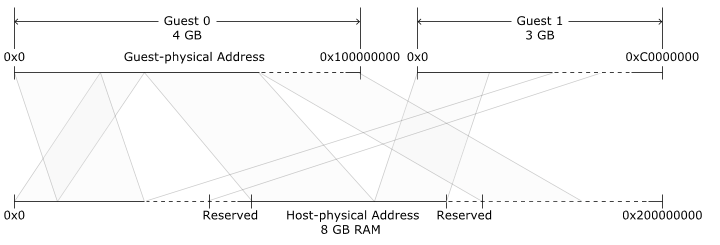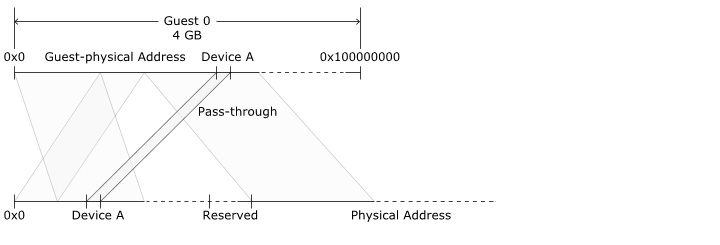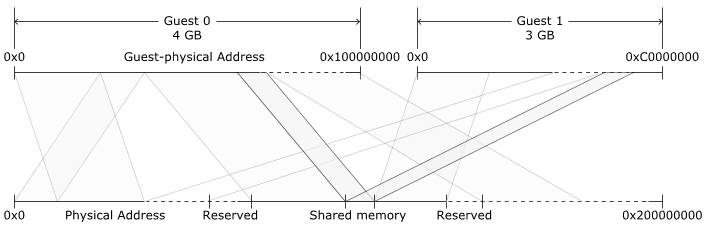In a QNX virtualized environment, the guest-physical memory that a guest sees as contiguous physical memory may in fact be discontiguous host-physical memory assembled by the virtualization.
A guest in a QNX virtualized environment uses memory for:
- normal operation (see “Memory in a virtualized environment”)
- accessing pass-through devices (see “Pass-through memory”)
- sharing information with other guests (“Shared memory”)
Note the following about memory in a QNX hypervisor:
- With the exception of shared memory (“Shared memory”), memory allocated to a VM is for the exclusive use of the guest hosted by the VM; that is, the address space for each guest is exclusive and independent of the address space of any other guest in the hypervisor system.
- If there isn't enough free memory on the system to complete the configured memory allocation for a VM, the hypervisor won't complete the configuration and won't start.
- If the memory allocated to its hosting VM is insufficient for a guest, the guest can't start, no matter how much memory is available on the board.
- With the exception of memory used for pass-through devices (see “Pass-through memory”) to prevent information leakage, the hypervisor zeroes memory before it allocates it to a VM.
Memory in a virtualized environment
In a QNX virtualized environment, a guest configured with 1 GB of RAM will see 1 GB available to it, just as it would see the RAM available to it if it were running in a non-virtualized environment. This memory allocation appears to the guest as physical memory. It is in fact memory assembled by the virtualization configuration from discontiguous physical memory. ARM calls this assembled memory intermediate physical memory; Intel calls it guest physical memory. For simplicity we will use guest-physical memory, regardless of the platform (see “Guest memory” in Terminology).
When you are configuring and accessing memory in a QNX virtualized environment, it is important to remember the following:
- The total amount of memory allocated to guests and any other use may not exceed the physical memory available on the board.
- Memory allocations must be in multiples of the QNX Neutrino OS 7.0 system page size (4 KB).
- The memory a guest sees is assembled from discontiguous blocks of memory. This guest-physical memory appears to the guest just like physical memory would appear to it in an unvirtualized system; for example, on x86 systems it would have the same gaps for legacy devices, etc.
- The apparently physical addresses a guest sees are in fact the guest-physical addresses in the guest-physical memory, which is assembled by the qvm process when it creates a VM.
- There is no correspondence between the address a guest sees (guest-physical address) and the physical address (host-physical address) to which the guest-physical address eventually translates below the virtualization layer.
 Figure 1. Illustration of how the memory a guest OS sees as contiguous physical memory
is assembled by the virtualization configuration from unrelated regions of
physical memory.
Figure 1. Illustration of how the memory a guest OS sees as contiguous physical memory
is assembled by the virtualization configuration from unrelated regions of
physical memory.The diagram above presents a simplified illustration of how in a QNX virtualized system guest memory allocations are assembled from discontiguous chunks of physical memory. To simplify the diagram, the memory allocation for Guest 1 is incomplete, and in the interests of legibility a gap has been added between the guests. Note also that some regions of physical memory may be reserved (e.g., for devices the board architecture requires at specific locations) and can't be allocated to a guest.
When you configure memory for guests, you need to configure the size of the memory allocation, and any platform-specifics, such as gaps for legacy devices (x86) or the RAM start address (ARM). The hypervisor looks after assembling blocks of physical memory into allocations of guest-physical memory for each guest.
Pass-through memory
Guests accessing physical devices as pass-through devices need to map these devices into the memory regions configured to be accessible to them. Note that the guest-physical address for a pass-through device will not necessarily be the same address as the host-physical address in the hypervisor domain. In other words, there is no correspondance between the physical address seen by the guest, and the physical address seen from the hypervisor host domain.
 Figure 2. Illustration of the guest-physical address for a pass-through device seen by
the guest as a physical address doesn't correspond to the host-physical address
of the device.
Figure 2. Illustration of the guest-physical address for a pass-through device seen by
the guest as a physical address doesn't correspond to the host-physical address
of the device.For example, Device A may be configured at 0x100 in Guest 0's physical memory. This device may be configured as a pass-through device for Guest 0 at this same location (0x100), so when Guest 0 needs to access the device, it looks at 0x100. However, we should remember that when a guest looks at a physical address, it is looking at a guest-physical address, which translates into some other address in host-physical memory, say 0xC00000100.
For more information about pass-through devices, see “Pass-through devices” in this chapter.
Configuring memory
To allocate memory for a virtual machine, you must allocate the memory required by each part of the system. You don't allocate all the memory for the VM in one chunk. Rather, you allocate the memory required for the image, then the memory required for your various devices, etc.
Many systems have reserved areas of memory. This is particularly true of x86 systems, which require many vestigial devices at specific locations. These rules apply to guests running in virtual environments, because the OSs are expecting the vestigial devices to be present.
When you allocate memory for a VM, it may be expedient and efficient to specify only the location of the bootable image in the guest-physical memory, and let the qvm process determine the best location for devices, shared memory, etc.
If a RAM location is to be used for the guest's bootable image, the guest must be configured to look for the image at this address inside its memory. In addition, if you use the qvm configuration load component to load your bootable image, the address where you load the image must match your guest's configuration. (If you don't specify the address, the qvm process looks after this for you.)
For example, for a QNX Neutrino OS guest, you might do the following:
Allocate RAM for the guest image with a start address in guest physical memory of 0x80000000:
ram 0x80000000,128M
Load the bootable image to this location:
load 0x80000000,/vm/images/qnx7.ifs
Specify this location in the guest's buildfile:
[image=0x80000000] [virtual=aarch64le,elf] .bootstrap = { [+keeplinked] startup-armv8_fm -v -H [+keeplinked] PATH=/proc/boot procnto -v }
See “ram” in the “VM Configuration Reference” chapter.
DMA device containment (smmuman)
The hypervisor uses an IOMMU/SMMU Manager (smmuman) that ensures that no pass-through device is able to access host-physical memory to which it has not been explicitly granted access.
For more information about the smmuman and smmuman-safety services and how to use them, see “DMA device containment (smmuman)” in the “QNX Hypervisor for Safety” chapter, and the SMMUMAN User's Guide.
